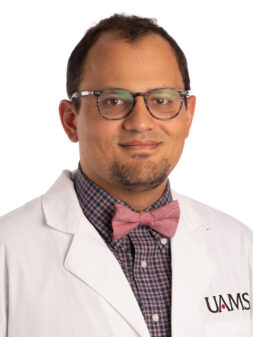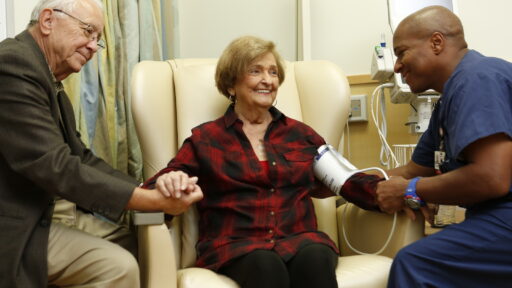Also called: Giant Lymph Node Hyperplasia; Lymphoid Hamartoma; Angiofollicular Lymph Node Hyperplasia
Overview
Castleman Disease (CD) describes a group of rare lymphoproliferative disorders that involve enlarged lymph nodes with characteristic microscopic changes and a broad range of inflammatory symptoms and laboratory abnormalities..Whether Castleman disease should be considered an autoimmune disease, cancer, or infectious disease is currently unknown. There are four main types of Castleman Disease: unicentric Castleman disease (UCD), which is localized and can involve one or more enlarged lymph nodes in a single region of the body, human herpesvirus 8 associated multicentric Castleman disease (HHV-8-associated MCD), POEMS-associated MCD, and idiopathic multicentric Castleman disease (iMCD), which is widespread and affects multiple lymph nodes and lymphatic tissues. Idiopathic multicentric Castleman disease (iMCD) can be further sub-classified into three clinical groups: .
- iMCD with TAFRO syndrome (iMCD-TAFRO) characterized by Thrombocytopenia, Anasarca, Fever, Renal dysfunction or Reticulin fibrosis and Organomegaly)
- iMCD with idiopathic plasmacytic lymphadenopathy (iMCD-IPL) characterized by thrombocytosis, hypergammaglobulinemia, and a more chronic disease course
- iMCD, not otherwise specified (iMCD-NOS) is diagnosed in iMCD patients without TAFRO syndrome or iMCD-IPL.
Key Statistics and Risk Factors
Approximately 4,300-5,200 new cases of Castleman Disease are diagnosed each year in the U.S. Unicentric Castleman disease is more common than multicentric Castleman disease, and can occur in people of any age, gender, or ethnicity affecting children as well as adults. It occurs most frequently in younger females. Multicentric CD (MCD) can be caused by a cancerous cell population (referred to as POEMS-associated MCD), an infection with human herpesvirus-8 (HHV-8-associated MCD), or an unknown cause (idiopathic MCD) where there are signs of autoimmunity but no evidence of an infection or a cancer. Thus, the various subtypes of CD can be described as either a benign tumor, a cancerous syndrome, an infectious disorder, or an autoimmune disease. All forms of CD involve elevated levels of cytokines, often including interleukin-6 (IL-6).
Having a weakened immune system is a risk factor for developing HHV-8-associated MCD but this is not a risk factor for any of the other subtypes of CD. There are no known risk factors for UCD, POEMS-associated MCD, or iMCD; there is no evidence of any food, lifestyle, or environmental exposure associated with these diseases. There is no known account of a patient contracting any form of CD from another individual.
Signs and Symptoms
Castleman disease can cause a variety of symptoms and severity is very broad, ranging from gradual enlargement of lymph nodes with mild symptoms to sudden, intense onset of symptoms due to life-threatening organ dysfunction caused by elevated cytokines such as IL-6. Multicentric Castleman disease usually includes widespread chronic swelling of the lymph nodes and sometimes enlargement of the liver and spleen.
Many people with unicentric Castleman disease have enlarged lymph nodes in one region and experience mild or no symptoms. When symptoms are present, they are usually due to compression of vital structures, such as the trachea, blood vessels or nerves, caused by enlarged lymph nodes.
What are the symptoms of Castleman Disease?
Symptoms of Unicentric Castleman Disease may include:
- A feeling of fullness or pressure in the chest or abdomen that can make breathing or eating difficult
- An enlarged lump under the skin in the neck, groin or armpit
- Fatigue
- Fullness in the face
- Weight loss
- Cough
- Anemia
- UCD symptoms can occur secondary to compression of surrounding structures by the enlarged lymph nodes.
- Less commonly, some UCD patients can experience systemic inflammatory symptoms such as fatigue and laboratory abnormalities such as low hemoglobin and elevated C-reactive protein.
Multicentric Castleman Disease usually includes widespread enlargement of the lymph nodes.The enlarged nodes can be in the chest or abdomen, groin or the underarm area. When present on the sides of the neck, they can often be seen or felt as lumps under the skin.
Multicentric Castleman disease can also affect lymphoid tissue of internal organs, such as the liver or spleen, causing them to enlarge. Enlarged organs might be seen or felt as masses under either side of the rib cage. They can cause a sense of fullness or pain in the abdomen and can interfere with eating.
Patients with MCD have enlarged lymph nodes in multiple regions and more severe symptoms. Signs and symptoms of multicentric Castleman disease (MCD) include:
- Flu-like symptoms: fever, fatigue, weight loss, night sweats, loss of appetite, nausea and vomiting
- Abnormally large lymph nodes, typically in the neck, armpit, collarbone, and groin
- Enlarged spleen or liver
- Cherry hemangioma
- Edema (swelling), ascites (fluid accumulation in the abdomen), and/or other symptoms of fluid accumulation
- Peripheral neuropathy (numbness in the hands and feet)
- Elevated inflammatory markers (C-reactive protein, erythrocyte sedimentation rate)
- Kidney dysfunction
- Low albumin
- Anemia (low amount of red blood cells)
- Low or high platelet counts
- Elevated immunoglobulins or gamma globulins
Diagnosing Castleman Disease
If symptoms or physical exam indicate that a patient might have a lymph node condition, the physician will get a thorough medical history, including details about symptoms, possible risk factors and other medical conditions. The physician will look for infection in the part of the body near the swollen lymph nodes, since infection is the most common cause of swollen lymph nodes.
According to international, evidence-based guidelines for UCD and iMCD from the Castleman Disease Collaborative Network, these tests should include:
- Lymph Node Biopsy: A doctor takes a sample of tissue from a lymph node and looks at it under a microscope to identify features of Castleman disease.
- Laboratory tests: Complete blood count, inflammation markers (CRP/ESR), and markers of organ function such as liver function tests, albumin, creatinine as well as HIV/HHV8 testing for HHV-8-associated MCD.
- Imaging tests: Tests such as X-rays and PET-CT scans allow doctors to locate enlarged lymph nodes and activity of those lymph nodes in the body.
Castleman Disease can only be diagnosed through biopsy (removing an enlarged lymph node) and examination under the microscope to identify features of Castleman disease
Treatment
In most cases of Unicentric Castleman disease, surgical removal of the mass is considered by experts to be the first-line treatment option. Adjuvant therapy, such as steroids and/or rituximab before surgery, can be useful to shrink a bulky tumor. Unicentric Castleman disease patients generally do well once the affected lymph node is removed. Sometimes, removing the enlarged lymph node(s) is not possible. If surgical excision is not possible, treatment is recommended for symptomatic patients. If symptoms are due to compression, then rituximab is recommended. If symptoms are due to an inflammatory syndrome, then anti-interleukin-6 (IL-6) therapy is recommended. If these treatments are not effective, then radiation may be needed.
Treatment of MCD can be challenging. Surgery is not usually an option in the case of multicentric Castleman disease because of the number of lymph nodes involved. Treatment generally includes medications and other therapies to control abnormal cell growth. Specific treatment depends on the extent of the disease and on whether there is associated HIV or HHV-8 infection or both.
Therapy options for HHV-8 positive Multicentric Castleman Disease include:
- Rituximab, which depletes the reservoir of HHV-8 positive B cells and significantly reduces the risk of lymphoma
- Etoposide, a chemotherapeutic agent, for more severely afflicted patients
- Maintenance therapy with valganciclovir, an antiviral agent
Therapy for POEMS-associated multicentric Castleman disease should be focused on plasma cell directed therapy such as multiple myeloma treatment regimens.
Therapy options for HHV-8 negative Multicentric Castleman Disease include:
- First-line treatment for iMCD is anti-IL-6 therapy with siltuximab or tocilizumab. Siltuximab is the only FDA-approved treatment for iMCD and patients who respond to siltuximab tend to have long-term responses.r. Siltuximab is a monoclonal antibody to the cytokineIL-6.
- Severe iMCD patients who are worsening while on siltuximab should be considered for the addition of cytotoxic chemotherapy.
- Immunosuppressants, immunomodulators, biologics, and cytotoxic chemotherapies, including cyclosporine, sirolimus, rituximab, bortezomib, thalildomide, anakinra, α-interferon, cyclophosphamide and etoposide are considered for patients not responding to siltuximab
- Autologous stem cell transplantation
A clinical trial for the medication sirolimus is currently open for iMCD patients who do not improve on siltuximab or tocilizumab. Patients can learn more about this trial at cdcn.org/trial or the federal registry for clinical trials here.
Prognosis
Unicentric Castleman Disease has an excellent prognosis. It usually does not progress to lymphoma, and surgically removing the tumor cures 90–95% of cases.
The outlook for patients with Multicentric Castleman Disease varies, depending on the specific nature of their disease. Some patients experience intense flares that can be deadly whereas others have more chronic symptoms. The historic 5-year overall survival has been around 65-75% but there is reason to believe that this will continue to improve with breakthrough therapies such as siltuximab.
The Future
The introduction of rituximab has been a major advance in HHV-8 positive multicentric Castleman disease. Therapy with IL-6-targeting monoclonals, such as siltuximab, has been an important innovation in HHV-8 negative multicentic Castleman disease. However, anti-IL-6 monoclonals are not effective for all patients.
The Myeloma Center participates with the Castleman Disease Collaborative Network to accelerate research and explore the causes of both unicentric and multicentric Castleman disease. The network includes a community of more than 800 physicians and researchers worldwide. Maximizing patient volume for historical studies is crucial for improving diagnostic criteria and patient care.
The Myeloma Center is the leading research and treatment center in the world for Castleman Disease. Clinical trials at the Myeloma Center offer an excellent opportunity for state-of-the art treatments that might otherwise not be available.
We encourage you to contact the Castleman Disease Collaborative Network (www.CDCN.org) to connect with other patients, identify a physician experienced with treating Castleman disease, learn about open clinical trials (www.CDCN.org/clinical-trials/), and participate in research opportunities, such as donating a blood sample to research (267) 586-9977, Castlebank@uphs.upenn.edu or joining the Castleman disease registry (www.CDCN.org/ACCELERATE).







